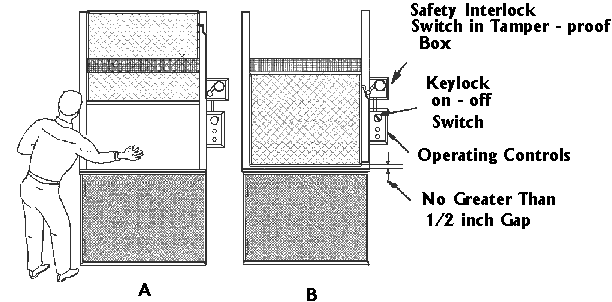
HC14
![]()
Personnel who load, operate, or maintain balers can be exposed to crushing and amputation hazards if the baler is inadequately safeguarded or if hazardous energy lockout procedures are not followed. Serious injuries and fatalities have occurred when part(s) of the worker's body was caught by the baler ram inside loading and baling chambers. In 1995, a National Institute for Occupational Safety and Health (NIOSH) field study found that some balers DO NOT meet the safeguarding requirements listed in the voluntary ANSI Z245.5-1990 Standard.
![]()
An amendment to the Fair Labor Standards Act, the principal law governing the employment of children under 18 years of age, became effective August 6, 1996. The amendment allows 16- and 17-year-olds, under certain conditions, to load material into, but not operate or maintain balers. However, the recommendations contained in this document are applicable to adult workers only.
Checklists that highlight the ANSI and OSHA standards are included on the following pages, with particular emphasis on the commonly-used vertical downstroke baler (see Figure 1). Users should review these checklists for safe baler operation. Based on its research, NIOSH recommends three criteria be satisfied to protect workers from injury during operation of paper balers:
ANSI STANDARD
The American National Standards Institute's "Baling Equipment-Safety Requirements" (ANSIZ245.5-1990) sets forth several requirements for "safety interlocks" and "safe lockout procedures" to stop or prevent hazardous motion of the baler's ram when open gates or access doors permit a person's hands, arms or body to be in the path of the ram (see Figure 2).
| ALL BALERS | |
|---|---|
| If access doors are lockable, the key should be kept by an authorized person. By location or design, interlock components should not be easy to tamper with. | |
| 16- and 17-year olds are allowed only to load balers and shall not operate or perform maintenance, including clearing jams from the machine. | |
| This indicates that the chamber door and latch have been designed to withstand the maximum ram forces on the material being baled. | |
| A clear line of sight from the baler to the disconnect avoids unexpected start-ups. | |
| Lockout is required for cleaning, jam clearing, and maintenance. Lockout procedures that must meet OSHA requirements are listed on page 4. | |
VERTICAL DOWNSTROKE BALERS | |
| Bale unloading is accomplished by upward ram motion, so a maintained-contact control (such as a push button) is appropriate. | |
| If the gate is opened more than 1/2 inch during the compression stroke, and ram movement continues, then the gate interlock is not functioning properly and needs to be repaired. | |
| A safe procedure for clearing scrap from the top of the ram should include locking out power. | |
| In addition to proper isolation and control of electrical energy during maintenance, the potential energy of the ram must be controlled by a blocking device of sufficient strength to resist downward ram motion. | |

Figure 1. Vertical Downstroke Baler: Basic Components

The OSHA standard (29 CFR 1910.147) has established minimum performance requirements for the control of hazardous energy. Six steps must occur, in the following sequence, prior to service or maintenance on a baler:
2. Shutdown: The baler shall be shutdown using orderly and established procedures.
3. Isolation: Electrical circuit interrupters or similar devices shall isolate the baler from the energy source.
4. Lockout/tagout device application: Lockout devices shall be affixed to each energy isolating device by authorized employees unless tagout devices can be demonstrated to provide full protection.
5. Energy due to gravity or hydraulic pressure: All potentially hazardous stored energy shall be relieved, disconnected, restrained, or otherwise rendered safe.
6. Verification of isolation: Prior to working on the baler, the authorized employee must verify that the baler has been isolated and deenergized.
2. Power on: Remove lockout devices and operate controls to restore power.
To obtain a free copy of the NIOSH* Report -- Review of Safeguarding Technology Used on Paper Balers (1995), or for information on other occupational safety and health issues:
-- visit the NIOSH Home Page on the World Wide Web at http://www.cdc.gov/niosh/homepage.html |
The principal contributors to this HAZARD CONTROLS are John R. Etherton, Cheryl F. Estill, G. Scott Earnest, and Jerome P. Flesch, NIOSH.
| This document is in the public domain and may be freely copied or reprinted. NIOSH encourages all readers of this HAZARD CONTROLS to make it available to all interested employers and workers. |
DHHS (NIOSH) Publication No. 97-113